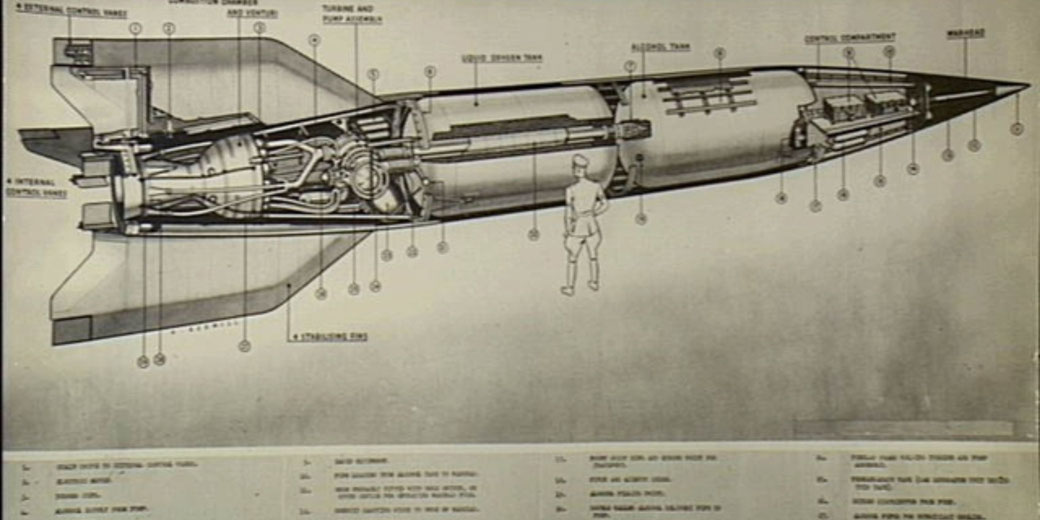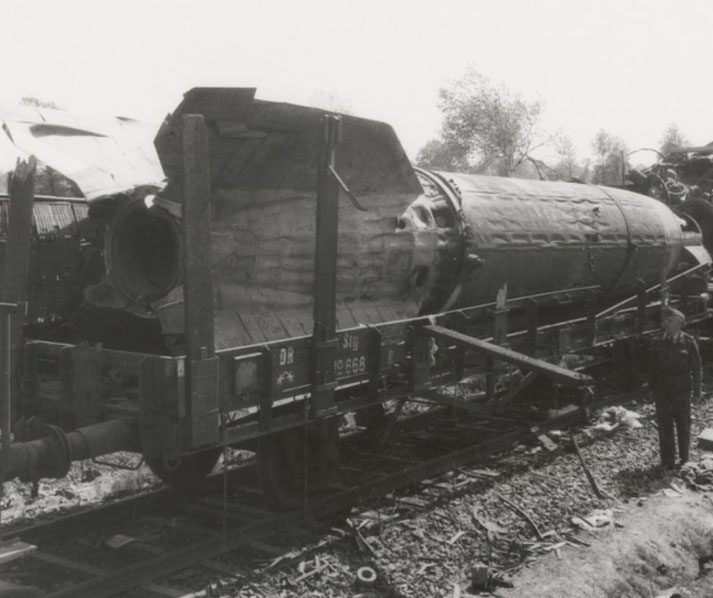Silent death from above: The devastating role of Hitler’s V-2 rockets in WWII

The V-2 Rocket, officially designated by the Germans as the A4, but more commonly known by its propaganda name, Vergeltungswaffe 2 (Retribution Weapon 2), was an unprecedented invention of its time.
It was the world's first long-range guided ballistic missile, a weapon that fused scientific innovation with destructive capability in a manner unseen before.
Its creation was driven by the vision of the Third Reich to possess a weapon that could not only inflict substantial damage but also sow seeds of fear among the Allied forces and populations.
The V-2 Rocket's genesis was intricately tied to the rise of Nazi Germany's technology. It showcased an amalgamation of ambitious scientific innovation and ruthless military strategy.
Its development was a testament to Germany's formidable engineering capabilities and its determination to explore novel war tactics.
It marked the inception of a new era in warfare, making distance and geographic barriers less of a constraint and opening up a new front: the skies above.
The Development of the V-2 Rocket
The development of the V-2 Rocket was a testament to the fusion of scientific vision and the ruthless execution of a military agenda.
Initiated in the early 1930s, this technological marvel was born out of a combination of ambition, necessity, and the relentless pursuit of power.
The concept of a long-range ballistic missile was not novel at the time. The theoretical framework had been laid out by visionaries like Konstantin Tsiolkovsky and Hermann Oberth.
However, transforming the theory into a practical, reliable weapon was an unprecedented challenge.
This task fell upon the shoulders of Wernher von Braun, who was appointed by the German Army to lead the development of the rocket program.
The primary development of the V-2 Rocket took place at the Peenemünde Army Research Center, located on the island of Usedom off the Baltic coast.
The facility was the nucleus of Germany's rocket program, fostering a host of advancements that would culminate in the creation of the V-2. Work at Peenemünde was carried out in secrecy, under the constant pressure of delivering a weapon that could change the course of the war.
Wernher von Braun and his team faced numerous technical hurdles in their endeavor.
Creating a rocket that could reach the edge of space, endure the tremendous heat and pressure of reentry, and deliver a warhead with reasonable accuracy was no small feat.
The team had to pioneer advancements in propulsion, guidance systems, and materials to achieve their goals.
It was a process marked by countless failures, iterations, and breakthroughs.
The V-2 Rocket project evolved through a series of prototypes. It was a process of trial and error, coupled with incremental improvements in design, materials, and engineering processes.
The breakthrough finally came in 1942, when a V-2 prototype successfully reached the edge of space, a feat never before achieved.

Technical Specifications and Capabilities
The V-2 rocket was a feat of engineering, showcasing a blend of innovation and pragmatism in its design.
Standing at approximately 14 meters in height and weighing around 13 tons fully fueled, the V-2 was an intimidating sight.
Its cylindrical body was made of lightweight aluminum, engineered for maximum strength and heat resistance, necessary for the rocket's arduous journey through Earth's atmosphere.
The rocket was propelled by an innovative liquid-fuel engine, using a combination of ethanol and liquid oxygen.
This engine was capable of generating approximately 56,000 pounds of thrust, propelling the rocket to the edge of space at a top speed of about 5,760 kilometers per hour (3,580 miles per hour).
At its peak, the V-2 could reach an altitude of approximately 189 kilometers (118 miles), effectively making it the world's first human-made object to reach the edge of space.
A crucial aspect of the V-2's design was its guidance system. The rocket utilized a simple yet effective gyroscopic system, aided by a radio control for course corrections.
This system allowed the V-2 to follow a preset trajectory, reaching its target with an unprecedented level of accuracy for a weapon of its time.
However, the true terror of the V-2 was its payload. The rocket was designed to carry a warhead weighing approximately one ton, filled with high explosives.
This destructive power, combined with the rocket's speed and range, made the V-2 a potent weapon.
Capable of a range of about 320 kilometers (200 miles), the V-2 could strike targets well beyond the reach of conventional artillery, delivering its deadly payload without warning.
Production and Deployment of the V-2 Rockets
The daunting task of mass-producing the technologically advanced V-2 rockets fell to the Mittelwerk factory, a vast complex built into the mountains of central Germany.
Using a labor force largely composed of concentration camp prisoners working in horrendous conditions, the Mittelwerk produced over 6,000 V-2 rockets between 1943 and the end of the war in Europe in May 1945.
The conditions at the Mittelwerk factory were grim, with workers forced to labor in hazardous environments, leading to many deaths from malnutrition, accidents, and maltreatment.
The use of forced labor for the V-2 program became one of the darkest chapters in the history of rocket development, a stark reminder of the human cost behind the advanced technology.
Once produced, the rockets were deployed to various launch sites across German-occupied Europe, primarily in the Netherlands and western Germany.
The V-2 rockets were launched from mobile launch platforms, which provided the German military with the flexibility to avoid detection and quickly change launch locations.
Impact of V-2 Rockets in World War II
The V-2 rocket, despite its technical challenges and controversies surrounding its production, had a significant impact on the course of World War II.
With its long-range capabilities and immense destructive power, the V-2 was a weapon unlike any other.
Notable attacks by V-2 rockets occurred across several locations, most significantly in London, Antwerp, and several other cities in England and mainland Europe.
London was the first city to be targeted by the V-2, with the first successful attack occurring in September 1944.
Over the next few months, hundreds of V-2s were fired at the city, causing widespread damage and significant civilian casualties.
Antwerp, a key port city supplying Allied forces, was another significant target of the V-2 attacks.
The city endured a continuous barrage of V-2 rockets from October 1944 to March 1945, resulting in considerable destruction and loss of life.
These attacks were intended to serve dual purposes - causing material damage and creating psychological terror.
The V-2 was a 'vengeance weapon,' meant to demoralize the civilian population and create a sense of constant dread.
Unlike conventional bombing raids, V-2 attacks came without warning, increasing their terror factor.
The rocket's supersonic speed meant it hit the target before the sound of its approach could be heard.
While the military and infrastructure damage caused by the V-2 was substantial, the human toll was even greater.
Thousands of civilians were killed or injured in the V-2 attacks. Many more were forced to live in a state of constant fear, never knowing when or where the next rocket would strike.
Beyond the physical and psychological devastation, the V-2 also had a significant impact on the war's direction by diverting Allied resources to defensive measures and counterattacks.
Efforts to disrupt the V-2 program through bombings of production facilities and launch sites became a priority for the Allies, marking a shift in strategic focus.
From Weapon of War to Space Exploration
While the V-2 rocket was created as a weapon of mass destruction, it ironically also laid the foundation for future exploration of space.
The technological advances made during the development of the V-2 would prove pivotal in the race to the stars that characterized the Cold War era.
As World War II came to an end, the victorious Allied forces sought to harness the technological advancements made by Nazi Germany.
The V-2 rocket was one such coveted technology. Both the United States and the Soviet Union seized remaining V-2 rockets and related equipment, along with recruiting key scientists involved in the V-2 program, in a bid to jump-start their respective missile and space programs.
In the United States, Operation Paperclip was initiated to bring German scientists, engineers, and technicians, including Wernher von Braun, to America.
These scientists played a vital role in the development of the American space program, with von Braun becoming a central figure in NASA's efforts to reach the moon.
Similarly, the Soviet Union undertook Operation Osoaviakhim, forcibly relocating thousands of German specialists to the Soviet Union to aid in their missile and space development programs.
These efforts led to the development of the R-1 missile, a direct copy of the V-2, which became the precursor to a series of advanced Soviet rockets.
Reflecting on the Legacy of the V-2 Rocket
The V-2 rocket was a manifestation of the Nazi's pursuit of a 'wonder weapon' that could alter the course of World War II.
With its innovative design, unparalleled range, and significant destructive power, it represented a seismic shift in the mechanics of warfare. It brought about a new dimension to the conflict – the skies above – instigating a race for technological superiority that would extend far beyond World War II.
Yet, the human cost of the V-2 program was immense. From the concentration camp prisoners forced to construct the rockets in inhumane conditions to the thousands of civilians who lost their lives in V-2 attacks, the suffering caused by the V-2 program was vast and profound.
This darker side of the V-2 story serves as a stark reminder of the moral and ethical dilemmas that often accompany technological advancement.
In the aftermath of World War II, the V-2 rocket's legacy lived on, but in a drastically different context. Its technology became the cornerstone of the space programs of the two superpowers of the 20th century, the United States and the Soviet Union.
Without the advancements pioneered by the V-2 program, achievements such as the launch of satellites and human space travel might have been delayed by many years.
What do you need help with?
Download ready-to-use digital learning resources
Copyright © History Skills 2014-2024.
Contact via email
With the exception of links to external sites, some historical sources and extracts from specific publications, all content on this website is copyrighted by History Skills. This content may not be copied, republished or redistributed without written permission from the website creator. Please use the Contact page to obtain relevant permission.





